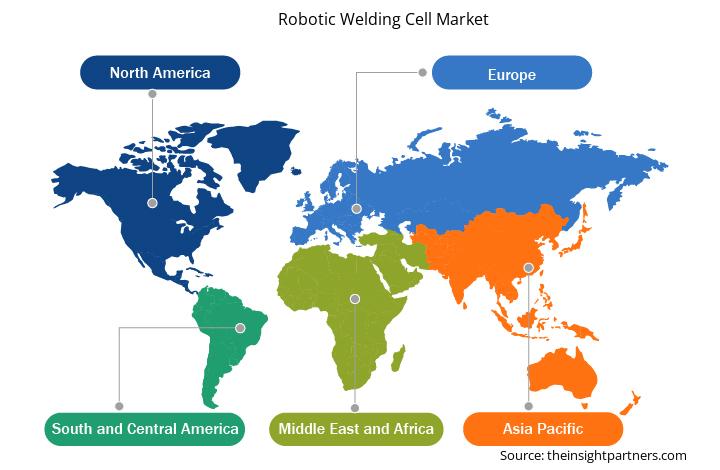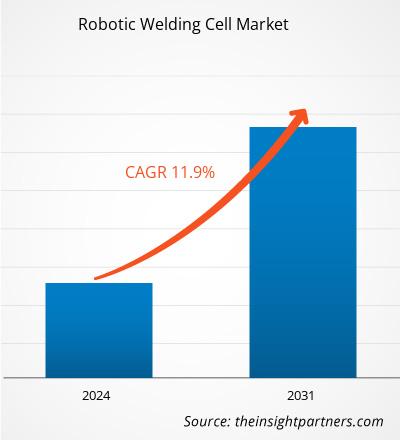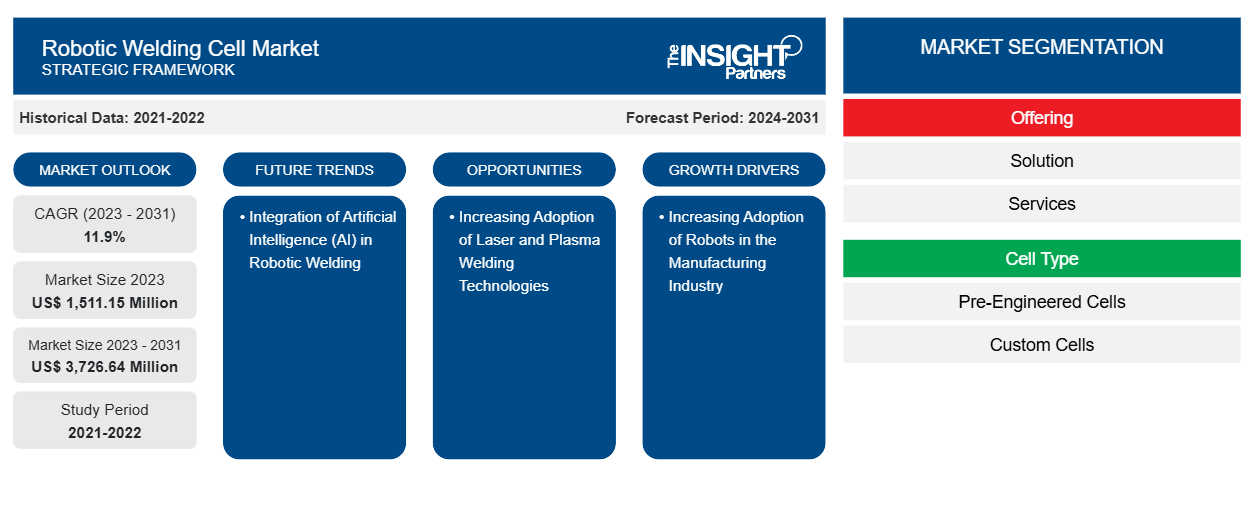Der Markt für Roboterschweißzellen soll von 1.511,15 Millionen US-Dollar im Jahr 2023 auf 3.726,64 Millionen US-Dollar im Jahr 2031 anwachsen. Der Markt soll zwischen 2023 und 2031 eine durchschnittliche jährliche Wachstumsrate (CAGR) von 11,9 % verzeichnen. Die zunehmende Einführung von Industrie 4.0-Technologien dürfte in den kommenden Jahren neue wichtige Trends auf dem Markt mit sich bringen.
Marktanalyse für Roboterschweißzellen
Eine Roboterschweißzelle besteht aus mehreren Komponenten, die zusammenarbeiten, um Teile zu schweißen. Roboterschweißzellen bieten Schweißvorgänge auf Weltklasseniveau und sind nach globalen Standards konzipiert, um Bedienerkosten und Zeit zu sparen. Vorgefertigte Zellen sind kosteneffiziente Roboterschweißzellen und enthalten nur die grundlegenden, für die Schweißprozesse erforderlichen Komponenten. Diese Grundstruktur der Zellen kann schnell installiert werden; sie ermöglicht es den Herstellern, die Zellproduktionszeit zu verkürzen und das Endprodukt frühestmöglich auszuliefern. Kundenspezifische Zellen sind im Vergleich zu vorgefertigten Zellen teuer, da sie neben grundlegenden, wesentlichen Komponenten auch einzigartige Geräte enthalten. Sie werden hauptsächlich nach den spezifischen Interessen des Kunden hergestellt. Daher ist die für die Herstellung und Lieferung einer kundenspezifischen Roboterschweißzelle erforderliche Zeit höher als die einer vorgefertigten Zelle. Schweißroboter werden in der Automobilindustrie häufig eingesetzt. Die Nachfrage nach Fahrzeugen steigt deutlich an. Die steigenden Verbraucherausgaben sind einer der Faktoren, die die Nachfrage nach Fahrzeugen weltweit antreiben, insbesondere in asiatischen Ländern. Gemäß den von der Internationalen Organisation der Kraftfahrzeughersteller im Jahr 2024 veröffentlichten Daten erreichte die Gesamtfahrzeugproduktion im Jahr 2023 93 Millionen, was einer Steigerung von 12 % von 2021 bis 2023 entspricht. Der Anstieg beim Bau neuer Anlagen hat zu einer erhöhten Nachfrage nach Schweißrobotern in diesen neuen Automobilanlagen geführt und letztlich den Markt für Roboterschweißzellen angetrieben.
Marktübersicht für Roboterschweißzellen
Zu den wichtigsten Interessenvertretern im globalen Ökosystem des Marktes für Roboterschweißzellen gehören Rohstoff-/Komponentenanbieter, Hersteller von Roboterschweißzellen, Regierungsorganisationen, Aufsichtsbehörden und Endkunden. Komponenten- und Hardwareanbieter liefern Herstellern von Roboterschweißzellen verschiedene Komponenten und Teile. Die wichtigsten Hersteller von Roboterschweißzellen, die in diesem Bericht aufgeführt sind, sind unter anderem Abb Ltd, Acieta LLC, Carl Cloos Schweisstechnik Gmbh, Kawasaki Heavy Industries, Ltd; Kuka AG; Phoenix Industrial Solutions; The Lincoln Electric Company; Wec Group Ltd.; und Yaskawa America, Inc. Neben den Herstellern von Roboterschweißzellen gibt es auf dem globalen Markt für Roboterschweißzellen mehrere Randinteressenten, die eine entscheidende Rolle bei der Ermöglichung des technologischen Fortschritts und der Einführung von Roboterschweißzellen spielen.
Passen Sie diesen Bericht Ihren Anforderungen an
Sie erhalten kostenlos individuelle Anpassungen an jedem Bericht, einschließlich Teilen dieses Berichts oder einer Analyse auf Länderebene, eines Excel-Datenpakets sowie tolle Angebote und Rabatte für Start-ups und Universitäten.
-
Holen Sie sich die wichtigsten Markttrends aus diesem Bericht.Dieses KOSTENLOSE Beispiel umfasst eine Datenanalyse von Markttrends bis hin zu Schätzungen und Prognosen.
Markttreiber und Chancen für Roboterschweißzellen
Zunehmender Einsatz von Robotern in der Fertigungsindustrie
Roboter spielen in der Fertigungsindustrie eine wichtige Rolle. Roboter tragen dazu bei, die Gesamteffizienz und Produktivität in Produktionsabläufen zu steigern. Sie werden in der Fertigungsindustrie für verschiedene Anwendungen eingesetzt, wie z. B. Montage und Dosierung, Handhabung und Kommissionierung, Bearbeitung und Schneiden, Schweißen und Löten, Gießen und Formen, Veredelung und Schleifen, Lackieren und Beschichten, Reinigung und Hygiene, Logistik und Lagerung sowie Verpackung und Palettierung. Laut den von der International Federation of Robots im Jahr 2024 veröffentlichten Daten waren im Jahr 2023 weltweit etwa 4,2 Millionen Roboter in Fabriken im Einsatz, ein Anstieg gegenüber 3,9 Millionen im Jahr 2022. Wie die International Federation of Robots im Jahr 2021 erklärte, wird die Hälfte aller in Fabriken arbeitenden Roboter für Schweißanwendungen eingesetzt. Der zunehmende Einsatz von Robotern in der Fertigungsindustrie treibt also das Wachstum des Marktes für Roboterschweißzellen voran.
Zunehmende Nutzung von Laser- und Plasmaschweißtechnologien
Die Nachfrage nach Laserschweißen steigt rasant. Bei der Laserschweißtechnologie werden hochenergetische Laserstrahlen verwendet, die mit Kohlendioxid, Stickstoff und Helium erzeugt werden. Dies hilft dabei, die Materialien mit hoher Präzision und Geschwindigkeit zu verbinden. Die Beliebtheit des Laserschweißens nimmt zu, da es nur minimale Verzerrungen erzeugt und verschiedene Materialien schweißen kann. Darüber hinaus kann durch die Verbesserung der Lasereffizienz und die Optimierung des Schweißprozesses mit dieser Art von Schweißtechnologie insgesamt Energie gespart werden. Dies ist einer der wichtigen Faktoren, die die Nachfrage nach Laserschweißen erhöhen, da die Reduzierung des Energieverbrauchs weltweit eines der Hauptanliegen ist.
Darüber hinaus kann diese Schweißtechnologie in Kombination mit fortschrittlichen Technologien wie KI und ML effizient arbeiten. Daher steigt die Nachfrage nach Laserschweißtechnologie deutlich an. Ebenso bietet die Plasmaschweißtechnologie verschiedene Vorteile, darunter eine hohe Leistungsdichte, saubere und glatte Schweißnähte, hohe Schweißgeschwindigkeit, geringe Verzerrung und verbesserte Spaltüberbrückung. Die durch Plasmaschweißen erzeugten Schweißnähte sind sehr stark und weniger sichtbar.
Segmentierungsanalyse des Marktberichts für Roboterschweißzellen
Wichtige Segmente, die zur Ableitung der Marktanalyse für Roboterschweißzellen beigetragen haben, sind Angebot, Zelltyp und Endverbrauchsbranche.
- Basierend auf dem Angebot ist der globale Markt für Roboterschweißzellen in Lösungen und Dienstleistungen unterteilt. Das Segment Lösungen hatte im Jahr 2023 einen größeren Marktanteil und wird im Prognosezeitraum voraussichtlich eine höhere CAGR verzeichnen. Roboterschweißzellenlösungen helfen Herstellern, ihre zusätzliche Produktionskapazität zu erreichen und Probleme des Arbeitskräftemangels zu mildern. Solche Vorteile von Roboterschweißzellen gegenüber manuellen Schweißprozessen treiben die Nachfrage nach Roboterschweißzellen an.
- Basierend auf dem Zelltyp ist der globale Markt für Roboterschweißzellen in vorgefertigte Zellen und kundenspezifische Zellen unterteilt. Das Segment der vorgefertigten Zellen dominierte das Zelltypsegment mit einem Marktanteil von 68,3 % im Jahr 2023, und das Segment der kundenspezifischen Zellen wird im Prognosezeitraum voraussichtlich eine höhere CAGR verzeichnen. Vorgefertigte Roboterschweißzellen sind standardmäßige Roboterschweißzellen, die einen größeren Arbeitsbereich mit einem längeren Robotermanipulator und zwei größeren Tischplatten haben. Auf der anderen Seite werden kundenspezifische Zellen gemäß den Anforderungen des Endbenutzers hergestellt und für bestimmte Branchen angepasst.
- Basierend auf der Endverbrauchsbranche ist der globale Markt für Roboterschweißzellen in die Bereiche Automobil, Fertigung sowie Luft- und Raumfahrt und Verteidigung unterteilt. Das Automobilsegment hatte den zweitgrößten Marktanteil und wird im Prognosezeitraum voraussichtlich die höchste Wachstumsrate verzeichnen. Einer der Faktoren, die die Nachfrage aus der Automobilindustrie antreiben, ist die zunehmende Produktion und der Verkauf von Fahrzeugen weltweit. Die Fertigungsindustrie wird im Prognosezeitraum voraussichtlich eine bemerkenswerte CAGR verzeichnen. Einer der Faktoren, die die Nachfrage nach Roboterschweißzellen im Fertigungssegment antreiben, ist der zunehmende Industrialisierungstrend weltweit, insbesondere in Entwicklungsländern.
Roboterschweißzellen Marktanteilsanalyse
Der geografische Umfang des Marktberichts für Roboterschweißzellen bietet eine detaillierte regionale und Länderanalyse. Nordamerika, Europa und der asiatisch-pazifische Raum sind wichtige Regionen, in denen der Markt für Roboterschweißzellen ein signifikantes Wachstum verzeichnet. China hatte im Jahr 2022 einen Marktanteil von fast 60 % an der Gesamtzahl der Roboterinstallationen. China installierte im Jahr 2022 etwa 0,2 Millionen Roboter, während Japan im Jahr 2022 mehr als 50.000 Einheiten installierte und damit der zweitgrößte Markt weltweit ist. Neben China und Japan sind Singapur, Indien und Thailand einige der wichtigsten Märkte im asiatisch-pazifischen Raum.
Europa hatte den zweitgrößten Marktanteil bei der Installation von Industrierobotern und der Roboterschweißzellenindustrie. Deutschland war 2023 der größte Markt in Europa für Roboterschweißzellen und Industrieroboter. Einer der Faktoren, die die Nachfrage nach Roboterschweißzellen antreiben, ist der Fokus auf die zunehmende Einführung von Industrie 4.0-Technologien in Deutschland. Deutschland, Frankreich, Großbritannien und Italien haben einige der größten Marktanteile auf dem Markt für Roboterschweißzellen.
Nordamerika ist einer der wichtigsten Märkte für Roboterschweißzellen, da dort einige bedeutende Fertigungsunternehmen aus allen Branchen vertreten sind, der Bedarf an Industrie 4.0 zunimmt und die Nachfrage nach fortschrittlicher Technologie steigt. Die USA hatten aufgrund der Industrialisierungs- und Digitalisierungstrends im Land den größten Marktanteil. Darüber hinaus sind die USA Sitz einiger großer Automobil- und Luftfahrtunternehmen wie Tesla, Boeing und Ford Motors.
Regionale Einblicke in den Markt für Roboterschweißzellen
Die regionalen Trends und Faktoren, die den Markt für Roboterschweißzellen im gesamten Prognosezeitraum beeinflussen, wurden von den Analysten von Insight Partners ausführlich erläutert. In diesem Abschnitt werden auch die Marktsegmente und die Geografie für Roboterschweißzellen in Nordamerika, Europa, im asiatisch-pazifischen Raum, im Nahen Osten und Afrika sowie in Süd- und Mittelamerika erörtert.

- Erhalten Sie regionale Daten zum Markt für Roboterschweißzellen
Umfang des Marktberichts für Roboterschweißzellen
| Berichtsattribut | Details |
|---|---|
| Marktgröße im Jahr 2023 | 1.511,15 Millionen US-Dollar |
| Marktgröße bis 2031 | 3.726,64 Millionen US-Dollar |
| Globale CAGR (2023 - 2031) | 11,9 % |
| Historische Daten | 2021-2022 |
| Prognosezeitraum | 2024–2031 |
| Abgedeckte Segmente |
Durch das Angebot
|
| Abgedeckte Regionen und Länder |
Nordamerika
|
| Marktführer und wichtige Unternehmensprofile |
|
Marktteilnehmerdichte für Roboterschweißzellen: Auswirkungen auf die Geschäftsdynamik verstehen
Der Markt für Roboterschweißzellen wächst rasant, angetrieben durch die steigende Nachfrage der Endnutzer aufgrund von Faktoren wie sich entwickelnden Verbraucherpräferenzen, technologischen Fortschritten und einem größeren Bewusstsein für die Vorteile des Produkts. Mit steigender Nachfrage erweitern Unternehmen ihr Angebot, entwickeln Innovationen, um die Bedürfnisse der Verbraucher zu erfüllen, und nutzen neue Trends, was das Marktwachstum weiter ankurbelt.
Die Marktteilnehmerdichte bezieht sich auf die Verteilung der Firmen oder Unternehmen, die in einem bestimmten Markt oder einer bestimmten Branche tätig sind. Sie gibt an, wie viele Wettbewerber (Marktteilnehmer) in einem bestimmten Marktraum im Verhältnis zu seiner Größe oder seinem gesamten Marktwert präsent sind.
Die wichtigsten Unternehmen auf dem Markt für Roboterschweißzellen sind:
- ABB Ltd.
- Acieta
- Carl Cloos Schweißtechnik GmbH
- Lincoln Electric Holdings Inc.
- Kuka AG
- Kawasaki Heavy Industries Ltd.
Haftungsausschluss : Die oben aufgeführten Unternehmen sind nicht in einer bestimmten Reihenfolge aufgeführt.

- Überblick über die wichtigsten Akteure auf dem Markt für Roboterschweißzellen
Neuigkeiten und aktuelle Entwicklungen zum Markt für Roboterschweißzellen
Der Markt für Roboterschweißzellen wird durch die Erhebung qualitativer und quantitativer Daten nach Primär- und Sekundärforschung bewertet, die wichtige Unternehmensveröffentlichungen, Verbandsdaten und Datenbanken umfasst. Nachfolgend sind einige der Entwicklungen auf dem Markt für Roboterschweißzellen aufgeführt:
- Die neue OmniVance FlexArc Compact-Zelle von ABB spart Platz und verleiht Schweißanwendungen mehr Flexibilität. ABB Ltd. hat seine OmniVance FlexArc Compact auf den Markt gebracht – eine neue, kleinere Schweißanwendungszelle mit größerer Flexibilität, Benutzerfreundlichkeit und besserer Integration, die Unternehmen dabei hilft, den Arbeitskräftemangel beim Schweißen zu beheben. Die OmniVance FlexArc Compact ist die kleinste Lichtbogenschweißzelle ihrer Klasse. Ihr innovatives 45-Grad-Portalroboter-Montagedesign maximiert die Arbeitsparameter des Roboters, indem es ihn in der Mitte eines dreiachsigen Drehtisches platziert und ihn so näher an das Werkstück bringt. (ABB Ltd., Unternehmenswebsite, Juni 2022)
Marktbericht zu Roboterschweißzellen – Abdeckung und Ergebnisse
Der Bericht „Marktgröße und Prognose für Roboterschweißzellen (2021–2031)“ bietet eine detaillierte Analyse des Marktes, die die folgenden Bereiche abdeckt:
- Marktgröße und Prognose für Roboterschweißzellen auf Länderebene für alle wichtigen Marktsegmente, die im Rahmen des Projekts abgedeckt sind
- Markttrends für Roboterschweißzellen sowie Marktdynamik wie Treiber, Einschränkungen und wichtige Chancen
- Detaillierte PEST- und SWOT-Analyse
- Marktanalyse für Roboterschweißzellen mit Blick auf wichtige Markttrends, Länderrahmen, wichtige Akteure, Vorschriften und aktuelle Marktentwicklungen
- Branchenlandschaft und Wettbewerbsanalyse, einschließlich Marktkonzentration, Heatmap-Analyse, prominenten Akteuren und aktuellen Entwicklungen auf dem Markt für Roboterschweißzellen
- Detaillierte Firmenprofile
- Historische Analyse (2 Jahre), Basisjahr, Prognose (7 Jahre) mit CAGR
- PEST- und SWOT-Analyse
- Marktgröße Wert/Volumen – Global, Regional, Land
- Branchen- und Wettbewerbslandschaft
- Excel-Datensatz
Aktuelle Berichte
Verwandte Berichte
Erfahrungsberichte
Grund zum Kauf
- Fundierte Entscheidungsfindung
- Marktdynamik verstehen
- Wettbewerbsanalyse
- Kundeneinblicke
- Marktprognosen
- Risikominimierung
- Strategische Planung
- Investitionsbegründung
- Identifizierung neuer Märkte
- Verbesserung von Marketingstrategien
- Steigerung der Betriebseffizienz
- Anpassung an regulatorische Trends























 Kostenlose Probe anfordern für - Markt für Roboterschweißzellen
Kostenlose Probe anfordern für - Markt für Roboterschweißzellen